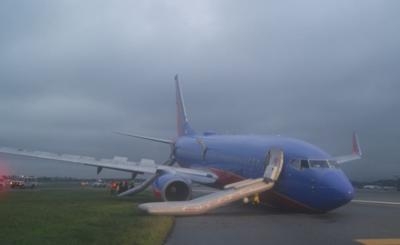Wed, Nov 12, 2014
Co-Pilot Was Flying The Aircraft At the Time, According To NTSB Documents
Documents released by the NTSB shows that the captain of a Southwest Airlines 737 landing at LaGuardia airport in New York pulled the power back during the approach while the co-pilot was flying the airplane, a violation of company and industry safety protocols.

The plane's nose gear collapsed when the airplane landed nose-first on the runway. Everyone was evacuated from the airplane, and nine suffered non-life-threatening injuries. Traffic was snarled at LaGuardia for several hours.
According to the documents posted on the NTSB's accident docket, the captain of the airplane placed her hand over the co-pilot's hand on the throttles and pulled them back unexpectedly. She did not announce that she was taking control of the airplane ... "I got it" ... until it was about 50 feet above the runway, according to a report from the Wall Street Journal.
The 49-year-old captain was fired by Southwest about two months after the incident. At the time, she had more than 7,500 hours flying 737s. The NTSB indicates that about three years before the incident, she was required by the airline to take remedial training because of her management style. First Officers reportedly complained regularly about her "overbearing attitude" in the cockpit.
The co-pilot is still flying for Southwest.
The captain had initially disputed the account of the accident given to the NTSB by the co-pilot, but the data from the Cockpit Voice Recorder backed up the co-pilot's story.
According to the NTSB's documents, the captain became concerned that the airplane was too high on the approach and suddenly pulled back power to the engines at about 100 feet. With the flaps extended, the airplane nosed down, and she was unable to recover before the nose gear hit the runway. The force of the impact was calculated to be about three times the weight of the airplane ... all on the nose gear ... and the plane skidded for nearly 20 seconds down the runway.
(Image provided by the NTSB)
More News
Outboard Section Of The Right Wing And The Right Flap Separated In Flight And The Airplane Impacted A Farm Field Analysis: The pilot was approaching his destination airport under i>[...]
Final Approach Fix The fix from which the final approach (IFR) to an airport is executed and which identifies the beginning of the final approach segment. It is designated on Gover>[...]
"Our choice of when to respond, how to respond and on which targets to respond is a consideration that we make every time... Netanyahu also noted that anyone attacking Israel &ldqu>[...]
Estimated (EST) When used in NOTAMs “EST” is a contraction that is used by the issuing authority only when the condition is expected to return to service prior to the e>[...]
Aero Linx: Coalition of Airline Pilots Associations (CAPA) The Coalition of Airline Pilots Associations (CAPA) is the world’s largest pilot trade association representing ove>[...]
 NTSB Final Report: Cessna 177B
NTSB Final Report: Cessna 177B ANN's Daily Aero-Term (05.08.25): Final Approach Fix
ANN's Daily Aero-Term (05.08.25): Final Approach Fix Aero-News: Quote of the Day (05.08.25)
Aero-News: Quote of the Day (05.08.25) ANN's Daily Aero-Term (05.09.25): Estimated (EST)
ANN's Daily Aero-Term (05.09.25): Estimated (EST) ANN's Daily Aero-Linx (05.09.25)
ANN's Daily Aero-Linx (05.09.25)



